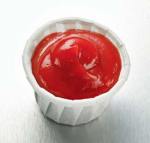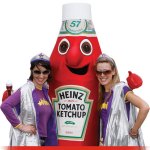My friend, Jane Odom, has a son, Chase, with an inquiring mind or perhaps an inquiring stomach. He wondered where the word ketchup came from, which suggests it’s in his lexicon and possibly a current high frequency item.
For most of us, ketchup is the tomato paste stuff that we buy in bottles and squeeze liberally over hot-dogs, French fries (chips to my UK readers), or into our spaghetti sauce. In fact, ketchup and steak sauce are possibly food staples for the majority of the population.
However, it seems that ketchup was originally used in a much more generic sense and you had to use a modifier to identity the specific ketchup under discussion, which means that I should really talk about tomato ketchup to describe more accurately the sense of ketchup with which we are familiar.
Before we dig into the origin of the word, it’s worth side-tracking a little to take a peek at the variations on ketchup.
When I first moved to the US in 1995, some friends gave my wife and I a gift; the classic Joy of Cooking by Irma Rombauer and Marion Rombauer Becker. This was originally published in 1931 and mine is the First Scribner Edition dated 1995, which means the language is about 75 years old. But there in the index is a reference to catsup, not ketchup, with three specific recipes; tomato catsup, grape catsup, and walnut catsup. The accompanying text says, “This condiment originated in Malaya, and its name derives from the native word for ‘taste.’ No other food so familiar to Americans seems to have so many variations in spelling.” (p.847).
And it does have some variations, although I’m not convinced there are “many.” Webster’s Dictionary includes catchup, as does the OED, and ketsup does occur across the Internet, but four variations hardly strikes me as prolific.
The Malayan derivation, kechap, was adopted as ketjap in Dutch, and this seems to be the origin that the Rombauers were alluding to. But it is more likely that this was derived from an earlier Chinese word, koechiap or ke-tsiap, a word used for the brine of pickled fish or shellfish.
Charles Payson Gurley Scott first mentioned the Malayan etymology in his 1986 article entitled The Malayan Words in English. But the word appears earlier than this in Charles Lockyer’s An account of the trade in India (1711) where he says, “Soy comes in Tubbs from Jappan, and the best Ketchup from Tonquin; yet good of both sorts are mae and sold very cheap in China.”
And if we accept the alternative, catchup, then this appears even earlier in E.B. Gent’s A new dictionary of the terms ancient and modern of the canting crew (1690) with the definition, “Catchup – a high East-India sauce.”
Heinz Ketchup was introduced to the public in 1876 with the tag line “Blessed relief for Mother and the other women in the household!”According to Heinz’s own web site, over 650 million bottles of Heinz Ketchup are sold around the world in more than 140 countries, with annual sales of more than $1.5 billion.
And some more fascinating ketchup trivia:
- One tablespoon has 16 calories and no fat
- Four tablespoons have the nutritional value of a medium ripe tomato
- Ketchup works well for restoring the shine to tarnished copper.
- Found in 97% of U.S. kitchens
Check back next week to “ketchup” on the next Word Guy posting!


